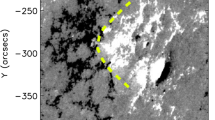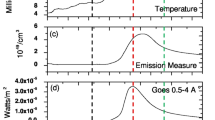Abstract
Many models of eruptive flares or coronal mass ejections (CMEs) involve formation of a current sheet connecting the ejecting CME flux rope with a magnetic loop arcade. However, there is very limited observational information on the properties and evolution of these structures, hindering progress in understanding eruptive activity from the Sun. In white-light images, narrow coaxial rays trailing the outward-moving CME have been interpreted as current sheets. Here, we undertake the most comprehensive statistical study of CME-rays to date. We use SOHO/LASCO data, which have a higher cadence, larger field of view, and better sensitivity than any previous coronagraph. We compare our results to a previous study of Solar Maximum Mission (SMM) CMEs, in 1984 – 1989, having candidate magnetic disconnection features at the CME base, about half of which were followed by coaxial bright rays. We examine all LASCO CMEs during two periods of minimum and maximum activity in Solar Cycle 23, resulting in many more events, \(\sim130\) CME-rays, than during SMM. Important results include: The occurrence rate of the rays is \(\sim11~\%\) of all CMEs during solar minimum, but decreases to \(\sim7~\%\) at solar maximum; this is most likely related to the more complex coronal background. The rays appear on average 3 – 4 hours after the CME core, and are typically visible for three-fourths of a day. The mean observed current sheet length over the ray lifetime is \(\sim12~R_{\odot}\), with the longest current sheet of \(18.5~R_{\odot}\). The mean CS growth rates are \(188~\mbox{km}\,\mathrm{s}^{-1}\) at minimum and \(324~\mbox{km}\,\mathrm{s}^{-1}\) at maximum. Outward-moving blobs within several rays, which are indicative of reconnection outflows, have average velocities of \(\sim350~\mbox{km}\,\mathrm{s}^{-1}\) with small positive accelerations. A pre-existing streamer is blown out in most of the CME-ray events, but half of these are observed to reform within \(\sim1\) day. The long lifetime and long lengths of the CME-rays challenge our current understanding of the evolution of the magnetic field in the aftermath of CMEs.











Similar content being viewed by others
Notes
Since St. Cyr’s LASCO CME catalog lists C-O features, we can check how many of those CME C-O events had rays that we identified. If we only take those CMEs with definite C-O structures, then during solar minimum 22 % (42 of 193) of the C-O CMEs had rays. A similar check for the 2001 maximum year could not be made because St. Cyr’s catalog stopped after June 1998 and the CDAW catalog does not list C-O features.
References
Bárta, M., Büchner, J., Karlický, M., Kotrč, P.: 2011, Astrophys. J. 730, 47. DOI .
Brueckner, G.E., Howard, R.A., Koomen, M.J., Korendyke, C.M., Michels, D.J., Moses, J.D., et al.: 1995, Solar Phys. 162, 357. DOI .
Burkepile, J.T., St. Cyr, O.C.: 1993, A revised and expanded catalogue of mass ejections observed by the solar maximum mission coronagraph. Rep. NCAR/TN-369+STR, Natl. Cent. for Atmos. Res., Boulder, CO.
Chen, P.F.: 2011, Living Rev. Solar Phys. 8, 1. DOI .
Chen, J., Howard, R.A., Brueckner, G.E., Santoro, R., Krall, J., Paswaters, S.E., St. Cyr, O.C., Schwenn, R., Lamy, P., Simnett, G.M.: 1997, Astrophys. J. 490, L191. DOI .
Ciaravella, A., Raymond, J.C., Li, J., Reiser, P., Gardner, L.D., Ko, Y.-K., Fineschi, S.: 2002, Astrophys. J. 575, 1116. DOI .
Ciaravella, A., Raymond, J.C., van Ballegooijen, A., Strachan, L., Vourlidas, A., Li, J., Chen, J., Panasyuk, A.: 2003, Astrophys. J. 597, 1118. DOI .
Ciaravella, A., Webb, D.F., Giordano, S., Raymond, J.C.: 2013, Astrophys. J. 766, 65. DOI .
DeForest, C.E., Howard, T.A., McComas, D.J.: 2012, Astrophys. J. 745, 36. DOI .
Dere, K.P., Brueckner, G.E., Howard, R.A., Michels, D.J, Delaboudiniere, J.P.: 1999, Astrophys. J. 516, 465. DOI .
Fisher, R.R., Lee, R.H., MacQueen, R.M., Poland, A.I.: 1981, Appl. Opt. 20, 1094. DOI .
Forbes, T.G., Acton, L.W.: 1996, Astrophys. J. 459, 330. DOI .
Giordano, S., Ciaravella, A., Raymond, J.C., Ko, Y.-K., Suleiman, R.: 2013, J. Geophys. Res. 118, 967. DOI .
Guo, L.-J., Bhattacharjee, A., Huang, Y.-M.: 2013, Astrophys. J. 771, L14. DOI .
Hundhausen, A.J.: 1993, J. Geophys. Res. 98, 13177. DOI .
Hundhausen, A.J., Burkepile, J.T., St. Cyr, O.C.: 1994, J. Geophys. Res. 99, 6543. DOI .
Kahler, S.W., Hundhausen, A.J.: 1992, J. Geophys. Res. 97, 1619. DOI .
Ko, Y., Raymond, J.C., Lin, J., Lawrence, G., Li, J., Fludra, A.: 2003, Astrophys. J. 594, 1068. DOI .
Kohl, J.L., Esser, R., Gardner, L.D., Habbal, S., Daigneau, P.S., Dennis, E.F., et al.: 1995, Solar Phys. 162, 313. DOI .
Kwon, Y., Vourlidas, A., Webb, D.: 2016, Astrophys. J. 826, 94. DOI .
Lin, J.: 2004, Solar Phys. 219, 169. DOI .
Lin, J., Forbes, T.G.: 2000, J. Geophys. Res. 105, 2375. DOI .
Lin, J., Raymond, J.C., van Ballegooijen, A.A.: 2004, Astrophys. J. 602, 422. DOI .
Lin, J., Ko, Y.-K., Sui, L., Raymond, J.C., Stenborg, G.A., Jiang, Y., Zhao, S., Mancuso, S.: 2005, Astrophys. J. 622, 1251. DOI .
Lin, J., Li, J., Forbes, T.G., Ko, Y.-K., Raymond, J.C., Vourlidas, A.: 2007, Astrophys. J. 658, L123. DOI .
Lin, J., Li, J., Ko, K., Raymond, J.C.: 2009, Astrophys. J. 693, 1666. DOI .
Lin, J., Murphy, N.A., Shen, C., Raymond, J.C., Reeves, K.K., Zhong, J., Wu, N., Li, Y.: 2015, Space Sci. Rev. 194, 237. DOI .
Ling, A.G., Webb, D.F., Burkepile, J.T., Cliver, E.W.: 2014, Astrophys. J. 784, 91. DOI .
Linker, J.A., Mikic, Z., Lionello, R., Riley, P., Amari, T., Odstrcil, D.: 2003, Phys. Plasmas 10, 1971. DOI .
MacQueen, R.M., Csoeke-Poeckh, A., Hildner, E., House, L., Reynolds, R., Stanger, A., Tepoel, H., Wagner, W.: 1980, Solar Phys. 65, 91. DOI .
McAllister, A.H., Dryer, M., McIntosh, P., Singer, H., Weiss, L.: 1996, J. Geophys. Res. 101(A6), 13497. DOI .
McComas, D.J., Gosling, J.T., Phillips, J.L.: 1992, J. Geophys. Res. 97, 171. DOI .
McComas, D.J., Gosling, J.T., Phillips, J.L., Bame, S.J., Luhmann, J.G., Smith, E.J.: 1989, J. Geophys. Res. 94, 6907. DOI .
Mei, Z., Shen, C., Wu, N., Lin, J., Murphy, N.A., Roussev, I.I.: 2012, Mon. Not. Roy. Astron. Soc. 425, 2824. DOI .
Parker, E.N.: 1957, J. Geophys. Res. 62, 509. DOI .
Patsourakos, S., Vourlidas, A.: 2011, Astron. Astrophys. 525, A27. DOI .
Patsourakos, S., Vourlidas, A., Stenborg, G.: 2010, Astrophys. J. 724, L188. DOI .
Petschek, H.E.: 1964, In: Hess, W.N. (ed.) The Physics of Solar Flares SP-50, NASA, Washington, 425.
Qiu, J.: 2015, How the dynamics of flare ribbons can help us understand the three-dimensional structure of reconnection. In: Triennial Earth–Sun Summit, TESS, Indianapolis, IN, 27–30 April, 2015, Abs. 104.02.
Reeves, K.K., Linker, J.A., Mikic, Z., Forbes, T.G.: 2010, Astrophys. J. 721, 1547. DOI .
Riley, P., Lionello, R., Mikic, Z., Linker, J., Clark, E., Lin, J., Ko, Y.-K.: 2007, Astrophys. J. 655, 591. DOI .
Savage, S.L., McKenzie, D.E., Reeves, K.K., Forbes, T.G., Longcope, D.W.: 2010, Astrophys. J. 722, 329. DOI .
Sheeley, N.R., Wang, Y.-M.: 2007, Astrophys. J. 655, 1142. DOI .
Shen, C., Lin, J., Murphy, N.A.: 2011, Astrophys. J. 737, 14. DOI .
Shibata, K., Masuda, S., Shimojo, M., Hara, H., Yokoyama, T., Tsuneta, S., Kosugi, T., Ogawara, Y.: 1995, Astrophys. J. 451, L83. DOI .
Simnett, G.M.: 2004, Astron. Astrophys. 416, 759. DOI .
Simnett, G.M., Tappin, S.J., Plunkett, S.P., Bedford, D.K., Eyles, C.J., St. Cyr, O.C., et al.: 1997, Solar Phys. 175, 685. DOI .
Song, H., Kong, X., Chen, Y., Li, B., Li, G., Feng, S., Xia, L.: 2012, Solar Phys. 276, 261. DOI .
St. Cyr, O.C., Howard, R.A., Sheeley, N.R. Jr., Plunkett, S.P., Michels, D.J., Paswaters, S.E., et al.: 2000, J. Geophys. Res. 105, 18169. DOI .
Svestka, Z., Cliver, E.W.: 1992, In: Svestka, Z., Jackson, B., Machado, M. (eds.) Eruptive Solar Flares, History and Basic Characteristics of Eruptive Flares, Springer, New York, 1.
Takasao, S., Asai, A., Isobe, H., Shibata, K.: 2012, Astrophys. J. 745, L6. DOI .
Vourlidas, A., Howard, R.A., Esfandiari, E., Patsourakos, S., Yashiro, S., Michalek, G.: 2010, Astrophys. J. 722, 1522. DOI .
Vourlidas, A., Howard, R.A., Esfandiari, E., Patsourakos, S., Yashiro, S., Michalek, G.: 2011, ERRATUM: “Comprehensive analysis of coronal mass ejection mass and energy properties over a full solar cycle” (2010, Astrophys. J., 722, 1522). Astrophys. J. 730, 59. DOI .
Vourlidas, A., Lynch, B.J., Howard, R.A., Li, Y.: 2013, Solar Phys. 284, 179. DOI .
Vrs̆nak, B., Poletto, G., Vujić, E., Vourlidas, A., Ko, Y.-K., Raymond, J.C., et al.: 2009, Astron. Astrophys. 499, 905. DOI .
Wang, Y.-M., Colaninno, R.: 2014, Astrophys. J. 784, L27. DOI .
Wang, Y.-M., Sheeley, N.R. Jr., Howard, R.A., Rich, N.B., Lamy, P.L.: 1999, Geophys. Res. Lett. 26, 1349. DOI .
Webb, D.F., Cliver, E.W.: 1995, J. Geophys. Res. 100, 5853. DOI .
Webb, D.F., Burkepile, J., Forbes, T.G., Riley, P.: 2003, J. Geophys. Res. 108(A12), 1. DOI (Paper 1).
Yashiro, S., Gopalswamy, N., Michalek, G., St. Cyr, O.C., Plunkett, S.P., Rich, N.B., Howard, R.A.: 2004, J. Geophys. Res. 109, A07105. DOI .
Yokoyama, T., Akita, K., Morimoto, T., Inoue, K., Newmark, J.: 2001, Astrophys. J. 546, L69. DOI .
Acknowledgements
This work was performed by D.F.W. at Boston College under NASA grants NNX09AB17G-R, NNX11AB61G, and NNX13AG54G. A.V. was supported by NNH13AV25I and internal APL funds. We are grateful to S. Yashiro and O.C. St. Cyr for data and helpful comments. The SOHO/LASCO data used here are produced by a consortium of the Naval Research Laboratory (USA), Max-Planck-Institut fuer Sonnensystemforschung (Germany), Laboratoire d’Astronomie (France), and the University of Birmingham (UK). SOHO is a project of international cooperation between ESA and NASA. We made extensive use of the SOHO/LASCO CDAW CME catalog, generated and maintained by the Center for Solar Physics and Space Weather, The Catholic University of America in cooperation with NRL and NASA. D.F.W. benefitted from a series of workshops on understanding the role of current sheets in solar eruptive phenomena at the International Space Sciences Institute (ISSI) in Bern, Switzerland.
Author information
Authors and Affiliations
Corresponding author
Ethics declarations
Conflict of interest
The authors declare that they have no conflicts of interest.
Rights and permissions
About this article
Cite this article
Webb, D.F., Vourlidas, A. LASCO White-Light Observations of Eruptive Current Sheets Trailing CMEs. Sol Phys 291, 3725–3749 (2016). https://doi.org/10.1007/s11207-016-0988-9
Received:
Accepted:
Published:
Issue Date:
DOI: https://doi.org/10.1007/s11207-016-0988-9




